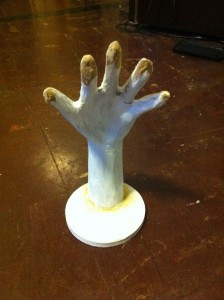The Hand of Fatima
Materials: cardboard, paper-mache, acrylic paint, glue, sand
This piece is an interpretation of the ubiquitous Islamic hamsa, also commonly known as the hand of Fatima. Hamsa means “five” in Arabic, a reference to the hand’s five fingers. The number five has tremendous symbolic significance in Islam. The Five Pillars of Islam are central to religious devotion and considered mandatory for all Muslims (with a few exceptions for illness, etc). The Five Pillars include the declaration of faith (shahadah), praying (salat), zakat (alms), fasting during Ramadan, and pilgrimage to Mecca (hajj). Within the Five Pillars, Muslims are instructed to pray five times per day and must adhere to five guidelines when giving alms to the poor. Shariah law delineates five categories of human behavior: the mandatory, the recommended, the discouraged, the forbidden, and the indifferent.
The hamsa symbol itself predates Islam and has been found in Mesopotamian and Ancient Greek artifacts. It is seen as a universal symbol of protection against evil, connoted by the eye at the center. The hamsa has been adopted by various religions, especially in the Middle East. Jews frequently refer to the hamsa as “the hand of Miriam,” and the symbol was adopted first by Sephardic Jews, who hail from the Middle East and North Africa. Christians, mostly of Arab descent in the Middle East, have also adopted the hamsa, calling it “the hand of Mary.”
My piece addresses Ahl al-Bayt, Muhammad’s immediate family and descendents. In one frequent interpretation (especially for Shia), the hamsa signifies these critical five members: Muhammad, his daughter Fatima, his son-in-law Ali, and his grandsons Hasan and Husein. In “The Miracle Play of Hasan and Husein,” translated by Sir Lewis Pelly, there is a dramatic reimagining of the battle of infamous Battle of Karbala, in which Husein is brutally killed. This tragic episode is of particular significance for Shia Muslims, who believe the line of succession runs through Ali and Fatima’s family. It also has broader implications for Shia practice, as it reinforced the notion that martyrdom and unification with God is associated with suffering.
In my piece, the sand symbolizes Husein’s martyrdom, as he has returned to the earth and God. The “evil eye” is that of Husein’s assailants. Though Husein is physically killed, he is ultimately taken into God’s hands in heaven. The black designs demonstrate that the arts can be associated with religious devotion and connection to God.


